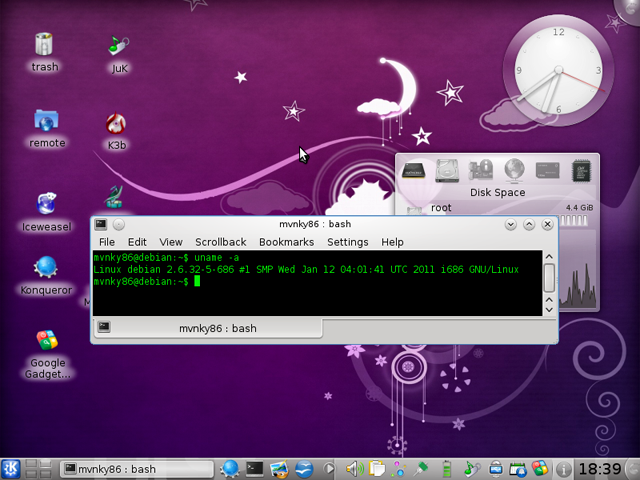Selasa, 07 Agustus 2012
Kamis, 24 Mei 2012
ARTIKEL LINUX
19.23
Linux
 |
|
|---|---|
| Company / developer | Many |
| Programmed in | Various |
| OS family | Unix-like |
| Working state | Current |
| Source model | Free and open source software |
| Initial release | 1991 |
| Latest stable release | Kernel: 3.4 (20 May 2012; 5 days ago)[1] [±] |
| Latest unstable release | Kernel: 3.4-rc7 (13 May 2012; 12 days ago)[2] [±] |
| Marketing target | Personal computers, embedded devices, mobile devices, servers |
| Available language(s) | Multilingual |
| Available programming languages(s) | Many |
| Supported platforms | Alpha, ARM, AVR32, Blackfin, C6x, ETRAX CRIS, FR-V, H8/300, Hexagon, Itanium, M32R, m68k, Microblaze, MIPS, MN103, OpenRISC, PA-RISC, PowerPC, s390, S+core, SuperH, SPARC, TILE64, Unicore32, x86, Xtensa |
| Kernel type | Monolithic |
| Userland | Various |
| Default user interface | Many |
| License | Many[3] ("Linux" trademark owned by Linus Torvalds[4] and administered by the Linux Mark Institute) |
Linux was originally developed as a free operating system for Intel x86-based personal computers. It has since been ported to more computer hardware platforms than any other operating system. It is a leading operating system on servers and other big iron systems such as mainframe computers and supercomputers:[12][13][14][15] more than 90% of today's 500 fastest supercomputers run some variant of Linux,[16] including the 10 fastest.[17] Linux also runs on embedded systems (devices where the operating system is typically built into the firmware and highly tailored to the system) such as mobile phones, tablet computers, network routers, televisions[18][19] and video game consoles; the Android system in wide use on mobile devices is built on the Linux kernel.
The development of Linux is one of the most prominent examples of free and open source software collaboration: the underlying source code may be used, modified, and distributed—commercially or non-commercially—by anyone under licenses such as the GNU General Public License. Typically Linux is packaged in a format known as a Linux distribution for desktop and server use. Some popular mainstream Linux distributions include Debian (and its derivatives such as Ubuntu), Fedora and openSUSE. Linux distributions include the Linux kernel, supporting utilities and libraries and usually a large amount of application software to fulfill the distribution's intended use.
A distribution oriented toward desktop use will typically include the X Window System and an accompanying desktop environment such as GNOME or KDE Plasma. Some such distributions may include a less resource intensive desktop such as LXDE or Xfce for use on older or less powerful computers. A distribution intended to run as a server may omit all graphical environments from the standard install and instead include other software such as the Apache HTTP Server and an SSH server such as OpenSSH. Because Linux is freely redistributable, anyone may create a distribution for any intended use. Applications commonly used with desktop Linux systems include the Mozilla Firefox web browser, the LibreOffice office application suite, and the GIMP image editor.
Since the main supporting user space system tools and libraries originated in the GNU Project, initiated in 1983 by Richard Stallman, the Free Software Foundation prefers the name GNU/Linux.[20][21]
Contents |
History
Main article: History of Linux
Unix
The Unix operating system was conceived and implemented in 1969 at AT&T's Bell Laboratories in the United States by Ken Thompson, Dennis Ritchie, Douglas McIlroy, and Joe Ossanna. It was first released in 1971 and was initially entirely written in assembly language, a common practice at the time. Later, in a key pioneering approach in 1973, Unix was re-written in the programming language C by Dennis Ritchie (with exceptions to the kernel and I/O). The availability of an operating system written in a high-level language allowed easier portability to different computer platforms. With a legal glitch forcing AT&T to license the operating system's source code to anyone who asked,[22] Unix quickly grew and became widely adopted by academic institutions and businesses. In 1984, AT&T divested itself of Bell Labs. Free of the legal glitch requiring free licensing, Bell Labs began selling Unix as a proprietary product.GNU
The GNU Project, started in 1983 by Richard Stallman, had the goal of creating a "complete Unix-compatible software system" composed entirely of free software. Work began in 1984.[23] Later, in 1985, Stallman started the Free Software Foundation and wrote the GNU General Public License (GNU GPL) in 1989. By the early 1990s, many of the programs required in an operating system (such as libraries, compilers, text editors, a Unix shell, and a windowing system) were completed, although low-level elements such as device drivers, daemons, and the kernel were stalled and incomplete.[24] Linus Torvalds has said that if the GNU kernel had been available at the time (1991), he would not have decided to write his own.[25]BSD
Although not released until 1992 due to legal complications, development of 386BSD, from which NetBSD and FreeBSD descended, predated that of Linux. Linus Torvalds has said that if 386BSD had been available at the time, he probably would not have created Linux.[26]MINIX
 |
 |
|
Andrew S. Tanenbaum (left), author of the MINIX operating system, and Linus Torvalds (right), principal author of the Linux kernel
|
||
In 1991 while attending the University of Helsinki, Torvalds became curious about operating systems[27] and frustrated by the licensing of MINIX, which limited it to educational use only. He began to work on his own operating system which eventually became the Linux kernel.
Torvalds began the development of the Linux kernel on MINIX, and applications written for MINIX were also used on Linux. Later Linux matured and further Linux development took place on Linux systems.[28] GNU applications also replaced all MINIX components, because it was advantageous to use the freely available code from the GNU project with the fledgling operating system. (Code licensed under the GNU GPL can be reused in other projects as long as they also are released under the same or a compatible license.) Torvalds initiated a switch from his original license, which prohibited commercial redistribution, to the GNU GPL.[29] Developers worked to integrate GNU components with Linux to make a fully functional and free operating system.[24]
Commercial and popular uptake
Main article: Linux adoption
Today, Linux systems are used in every domain, from embedded systems to supercomputers,[15][30] and have secured a place in server installations often using the popular LAMP application stack.[31] Use of Linux distributions in home and enterprise desktops has been growing.[32][33][34][35][36][37][38]
They have also gained popularity with various local and national
governments. The federal government of Brazil is well known for its
support for Linux.[39][40]
News of the Russian military creating its own Linux distribution has
also surfaced, and has come to fruition as the G.H.ost Project.[41] The Indian state of Kerala has gone to the extent of mandating that all state high schools run Linux on their computers.[42][43] China uses Linux exclusively as the operating system for its Loongson processor family to achieve technology independence.[44] In Spain some regions have developed their own Linux distributions, which are widely used in education and official institutions, like gnuLinEx in Extremadura and Guadalinex in Andalusia. Portugal is also using its own Linux distribution Caixa Mágica, used in the Magalhães netbook[45] and the e-escola government program.[46] France and Germany have also taken steps toward the adoption of Linux.[47]Linux distributions have also become popular in the netbook market, with many devices such as the ASUS Eee PC and Acer Aspire One shipping with customized Linux distributions installed.[48]
Current development
Torvalds continues to direct the development of the kernel.[49] Stallman heads the Free Software Foundation,[50] which in turn supports the GNU components.[51] Finally, individuals and corporations develop third-party non-GNU components. These third-party components comprise a vast body of work and may include both kernel modules and user applications and libraries. Linux vendors and communities combine and distribute the kernel, GNU components, and non-GNU components, with additional package management software in the form of Linux distributions.Design
| This unreferenced section requires citations to ensure verifiability. |
Separate projects that interface with the kernel provide much of the system's higher-level functionality. The GNU userland is an important part of most Linux-based systems, providing the most common implementation of the C library, a popular shell, and many of the common Unix tools which carry out many basic operating system tasks. The graphical user interface (or GUI) used by most Linux systems is built on top of an implementation of the X Window System.
User interface
| This section needs additional citations for verification. Please help improve this article by adding citations to reliable sources. Unsourced material may be challenged and removed. (August 2011) |
See also: User interface
Users operate a Linux-based system through a command line interface (CLI), a graphical user interface
(GUI), or through controls attached to the associated hardware, which
is common for embedded systems. For desktop systems, the default mode is
usually a graphical user interface, by which the CLI is available
through terminal emulator windows or on a separate virtual console. Most low-level Linux components, including the GNU userland,
use the CLI exclusively. The CLI is particularly suited for automation
of repetitive or delayed tasks, and provides very simple inter-process communication. A graphical terminal emulator program is often used to access the CLI from a Linux desktop. A Linux system typically implements a CLI by a shell,
which is also the traditional way of interacting with a Unix system. A
Linux distribution specialized for servers may use the CLI as its only
interface.On desktop systems, the most popular user interfaces are the extensive desktop environments KDE Plasma Desktop, GNOME, and Xfce,[52] though a variety of additional user interfaces exist. Most popular user interfaces are based on the X Window System, often simply called "X". It provides network transparency and permits a graphical application running on one system to be displayed on another where a user may interact with the application.[53]
Other GUIs may be classified as simple X window managers, such as FVWM, Enlightenment, and Window Maker, which provide a minimalist functionality with respect to the desktop environments. A window manager provides a means to control the placement and appearance of individual application windows, and interacts with the X Window System. The desktop environments include window managers as part of their standard installations (Mutter for GNOME, KWin for KDE, Xfwm for Xfce as of January 2012) although users may choose to use a different window manager if preferred.
Development
Main article: Linux distribution
The primary difference between Linux and many other popular contemporary operating systems is that the Linux kernel and other components are free and open source software. Linux is not the only such operating system, although it is by far the most widely used.[54] Some free and open source software licenses are based on the principle of copyleft, a kind of reciprocity: any work derived from a copyleft piece of software must also be copyleft itself. The most common free software license, the GNU GPL, is a form of copyleft, and is used for the Linux kernel and many of the components from the GNU project.Linux based distributions are intended by developers for interoperability with other operating systems and established computing standards. Linux systems adhere to POSIX,[55] SUS,[56] ISO, and ANSI standards where possible, although to date only one Linux distribution has been POSIX.1 certified, Linux-FT.[57][58]
Free software projects, although developed in a collaborative fashion, are often produced independently of each other. The fact that the software licenses explicitly permit redistribution, however, provides a basis for larger scale projects that collect the software produced by stand-alone projects and make it available all at once in the form of a Linux distribution.
A Linux distribution, commonly called a "distro", is a project that manages a remote collection of system software and application software packages available for download and installation through a network connection. This allows users to adapt the operating system to their specific needs. Distributions are maintained by individuals, loose-knit teams, volunteer organizations, and commercial entities. A distribution is responsible for the default configuration of the installed Linux kernel, general system security, and more generally integration of the different software packages into a coherent whole. Distributions typically use a package manager such as dpkg, Synaptic, YAST, or Portage to install, remove and update all of a system's software from one central location.
Community
See also: Free software community and Linux User Group
A distribution is largely driven by its developer and user
communities. Some vendors develop and fund their distributions on a
volunteer basis, Debian being a well-known example. Others maintain a community version of their commercial distributions, as Red Hat does with Fedora and Novell does with openSUSE.In many cities and regions, local associations known as Linux User Groups (LUGs) seek to promote their preferred distribution and by extension free software. They hold meetings and provide free demonstrations, training, technical support, and operating system installation to new users. Many Internet communities also provide support to Linux users and developers. Most distributions and free software / open source projects have IRC chatrooms or newsgroups. Online forums are another means for support, with notable examples being LinuxQuestions.org and the various distribution specific support and community forums, such as ones for Ubuntu, Fedora, and Gentoo. Linux distributions host mailing lists; commonly there will be a specific topic such as usage or development for a given list.
There are several technology websites with a Linux focus. Print magazines on Linux often include cover disks including software or even complete Linux distributions.[59][60]
Although Linux distributions are generally available without charge, several large corporations sell, support, and contribute to the development of the components of the system and of free software. An analysis of the Linux kernel showed 75 percent of the code from December 2008 to January 2010 was developed by programmers working for corporations, leaving about 18 percent to volunteers and 7% unclassified.[61] Some of the major corporations that contribute include Dell, IBM, HP, Oracle, Sun Microsystems (now part of Oracle), Novell, and Nokia. A number of corporations, notably Red Hat and Novell, have built a significant business around Linux distributions.
The free software licenses, on which the various software packages of a distribution built on the Linux kernel are based, explicitly accommodate and encourage commercialization; the relationship between a Linux distribution as a whole and individual vendors may be seen as symbiotic. One common business model of commercial suppliers is charging for support, especially for business users. A number of companies also offer a specialized business version of their distribution, which adds proprietary support packages and tools to administer higher numbers of installations or to simplify administrative tasks.
Another business model is to give away the software in order to sell hardware. This used to be the norm in the computer industry, with operating systems such as CP/M, Apple DOS and versions of Mac OS prior to 7.5 freely copyable (but not modifiable). As computer hardware standardized throughout the 1980s, it became more difficult for hardware manufacturers to profit from this tactic, as the OS would run on any manufacturer's computer that shared the same architecture.
Programming on Linux
Most Linux distributions support dozens of programming languages. The original development tools used for building both Linux applications and operating system programs are found within the GNU toolchain, which includes the GNU Compiler Collection (GCC) and the GNU build system. Amongst others, GCC provides compilers for Ada, C, C++, Java, and Fortran. First released in 2003, the Low Level Virtual Machine project provides an alternative open-source compiler for many languages. Proprietary compilers for Linux include the Intel C++ Compiler, Sun Studio, and IBM XL C/C++ Compiler. BASIC in the form of Visual Basic is supported in such forms as Gambas, FreeBASIC, and XBasic.Most distributions also include support for PHP, Perl, Ruby, Python and other dynamic languages. While not as common, Linux also supports C# (via Mono), Vala, and Scheme. A number of Java Virtual Machines and development kits run on Linux, including the original Sun Microsystems JVM (HotSpot), and IBM's J2SE RE, as well as many open-source projects like Kaffe and JikesRVM.
GNOME and KDE are popular desktop environments and provide a framework for developing applications. These projects are based on the GTK+ and Qt widget toolkits, respectively, which can also be used independently of the larger framework. Both support a wide variety of languages. There are a number of Integrated development environments available including Anjuta, Code::Blocks, CodeLite, Eclipse, Geany, ActiveState Komodo, KDevelop, Lazarus, MonoDevelop, NetBeans, Qt Creator and Omnis Studio, while the long-established editors Vim and Emacs remain popular.[62]
Uses
As well as those designed for general purpose use on desktops and servers, distributions may be specialized for different purposes including: computer architecture support, embedded systems, stability, security, localization to a specific region or language, targeting of specific user groups, support for real-time applications, or commitment to a given desktop environment. Furthermore, some distributions deliberately include only free software. Currently, over three hundred distributions are actively developed, with about a dozen distributions being most popular for general-purpose use.[63]Linux is a widely ported operating system kernel. The Linux kernel runs on a highly diverse range of computer architectures: in the hand-held ARM-based iPAQ and the mainframe IBM System z9, System z10; in devices ranging from mobile phones to supercomputers.[64] Specialized distributions exist for less mainstream architectures. The ELKS kernel fork can run on Intel 8086 or Intel 80286 16-bit microprocessors, while the µClinux kernel fork may run on systems without a memory management unit. The kernel also runs on architectures that were only ever intended to use a manufacturer-created operating system, such as Macintosh computers (with both PowerPC and Intel processors), PDAs, video game consoles, portable music players, and mobile phones.
There are several industry associations and hardware conferences devoted to maintaining and improving support for diverse hardware under Linux, such as FreedomHEC.
Desktop
Main article: Desktop Linux
The popularity of Linux on standard desktop computers and laptops has been increasing over the years.[65] Currently most distributions include a graphical user environment, with the two most popular environments being GNOME (which can utilize additional shells such as the default GNOME Shell and Ubuntu Unity), and the KDE Plasma Desktop.The performance of Linux on the desktop has been a controversial topic; for example in 2007 Con Kolivas accused the Linux community of favoring performance on servers. He quit Linux kernel development because he was frustrated with this lack of focus on the desktop, and then gave a "tell all" interview on the topic.[66] Since then a significant amount of development has been undertaken in an effort to improve the desktop experience. Projects such as Upstart and systemd aim for a faster boot time.
Many popular applications are available for a wide variety of operating systems. For example Mozilla Firefox, OpenOffice.org/LibreOffice and Blender have downloadable versions for all major operating systems. Furthermore, some applications were initially developed for Linux, such as Pidgin, and GIMP, and were ported to other operating systems including Windows and Mac OS X due to their popularity. In addition, a growing number of proprietary desktop applications are also supported on Linux;[67] see List of proprietary software for Linux. In the field of animation and visual effects, most high end software, such as Autodesk Maya, Softimage XSI and Apple Shake, is available for Linux, Windows and/or Mac OS X. There are also several companies that have ported their own or other companies' games to Linux.
Many types of applications available for Microsoft Windows and Mac OS X are also available for Linux. Commonly, either a free software application will exist which does the functions of an application found on another operating system, or that application will have a version that works on Linux, such as with Skype and some video games.[citation needed] Furthermore, the Wine project provides a Windows compatibility layer to run unmodified Windows applications on Linux. CrossOver is a proprietary solution based on the open source Wine project that supports running Windows versions of Microsoft Office, Intuit applications such as Quicken and QuickBooks, Adobe Photoshop versions through CS2, and many popular games such as World of Warcraft and Team Fortress 2. In other cases, where there is no Linux port of some software in areas such as desktop publishing[68] and professional audio,[69][70][71] there is equivalent software available on Linux.
The collaborative nature of free software development allows distributed teams to perform language localization of some Linux distributions for use in locales where localizing proprietary systems would not be cost-effective. For example the Sinhalese language version of the Knoppix distribution was available significantly before Microsoft Windows XP was translated to Sinhalese.[citation needed] In this case the Lanka Linux User Group played a major part in developing the localized system by combining the knowledge of university professors, linguists, and local developers.
Installing, updating and removing software in Linux is typically done through the use of package managers such as the Synaptic Package Manager, PackageKit, and Yum Extender. While most major Linux distributions have extensive repositories, often containing tens of thousands of packages, not all the software that can run on Linux is available from the official repositories. Alternatively, users can install packages from unofficial repositories, download pre-compiled packages directly from websites, or compile the source code by themselves. All these methods come with different degrees of difficulty; compiling the source code is in general considered a challenging process for new Linux users, but it's hardly needed in modern distributions and is not a method specific to Linux.
Servers, mainframes and supercomputers
The Oak Ridge National Laboratory's Jaguar supercomputer, until recently the world's fastest supercomputer. It uses the Cray Linux Environment as its operating system.[72][73]
Linux distributions are the cornerstone of the LAMP server-software combination (Linux, Apache, MySQL, Perl/PHP/Python) which has achieved popularity among developers, and which is one of the more common platforms for website hosting.[77]
Linux distributions have become increasingly popular on mainframes in the last decade partly due to pricing and the open-source model.[15][citation needed] In December 2009, computer giant IBM reported that it would predominantly market and sell mainframe-based Enterprise Linux Server.[78]
Linux distributions are also commonly used as operating systems for supercomputers: since November 2010, out of the top 500 systems, 459 (91.8%) run a Linux distribution.[79] Linux was also selected as the operating system for the world's most powerful supercomputer, IBM's Sequoia which was scheduled to become operational in 2011.[80][clarification needed]
Embedded devices
See also: Embedded Linux and Linux devices
Market share and uptake
Main article: Linux adoption
See also: Usage share of operating systems
Many quantitative studies of free
/ open source software focus on topics including market share and
reliability, with numerous studies specifically examining Linux.[85]
The Linux market is growing rapidly, and the revenue of servers,
desktops, and packaged software running Linux was expected to exceed
$35.7 billion by 2008.[86]IDC's Q1 2007 report indicated that Linux held 12.7% of the overall server market at that time.[87] This estimate was based on the number of Linux servers sold by various companies, and did not include server hardware purchased separately which had Linux installed on it later. In September 2008 Microsoft CEO Steve Ballmer admitted that 60% of web-servers run Linux versus 40% that run Windows Server.[88]
Primarily based on web server statistics, various companies estimated that the desktop market share of Linux range from less than 1% to 4.8%.[89] In comparison, Microsoft operating systems hold more than 85%.[32][33][34][35][36][37][38][90][91]
Analysts and proponents attribute the relative success of Linux to its security, reliability, low cost, and freedom from vendor lock-in.[92][93]
The Wine compatibility layer allows users to run many programs designed for Windows under Linux.[94] About half of Wine's code has been contributed by volunteers and half sponsored by commercial interests including CodeWeavers, which produces a commercial version of the software. Since 2009, Google has also provided funding to the Wine project.[95][96]
The XO laptop project of One Laptop Per Child is creating a new and potentially much larger Linux community which is planned to reach millions of schoolchildren and their families in the developing world.[97] Major supporters of the project include Google, Red Hat, and eBay.[98] Although the XO will have a Windows option, it will be primarily deployed with Fedora Linux while using Sugar as the desktop environment.
For years Linux has been the platform of choice in the film industry. The first major film produced on Linux servers was 1997's Titanic.[99][100] Since then major studios including Dreamworks Animation, Pixar, Weta Digital, and Industrial Light & Magic have migrated to Linux.[101][102][103] According to the Linux Movies Group, more than 95% of the servers and desktops at large animation and visual effects companies use Linux.[104]
Copyright, trademark, and naming
See also: SCO-Linux controversies
Linux and most GNU software are licensed under the GNU General Public License
(GPL). The GPL requires that anyone who distributes Linux must make the
source code (and any modifications) available to the recipient under
the same terms. Other key components of a software system may use other
licenses; many libraries use the GNU Lesser General Public License (LGPL), a more permissive variant of the GPL, and the X.org implementation of the X Window System uses the MIT License.Torvalds states that the Linux kernel will not move from version 2 of the GPL to version 3. He specifically dislikes some provisions in the new license which prohibit the use of the software in digital rights management,[105][106] and it would also be impractical to obtain permission from all the copyright holders, who number in the thousands.[107]
A 2001 study of Red Hat Linux 7.1 found that this distribution contained 30 million source lines of code.[108] Using the Constructive Cost Model, the study estimated that this distribution required about eight thousand man-years of development time. According to the study, if all this software had been developed by conventional proprietary means, it would have cost about $1.46 billion (2012 US dollars) to develop in the United States.[108]
Most of the code (71%) was written in the C programming language, but many other languages were used, including C++, Lisp, assembly language, Perl, Python, Fortran, and various shell scripting languages. Slightly over half of all lines of code were licensed under the GPL. The Linux kernel itself was 2.4 million lines of code, or 8% of the total.[108]
In a later study, the same analysis was performed for Debian GNU/Linux version 4.0 (etch, which was released in 2007).[109] This distribution contained close to 283 million source lines of code, and the study estimated that it would have required about seventy three thousand man-years and cost US$8.04 billion (in 2012 dollars) to develop by conventional means.
In the United States, the name Linux is a trademark registered to Linus Torvalds.[4] Initially, nobody registered it, but on 15 August 1994, William R. Della Croce, Jr. filed for the trademark Linux, and then demanded royalties from Linux distributors. In 1996, Torvalds and some affected organizations sued him to have the trademark assigned to Torvalds, and in 1997 the case was settled.[110] The licensing of the trademark has since been handled by the Linux Mark Institute. Torvalds has stated that he trademarked the name only to prevent someone else from using it. LMI originally charged a nominal sublicensing fee for use of the Linux name as part of trademarks,[111] but later changed this in favor of offering a free, perpetual worldwide sublicense.[112]
GNU/Linux
Main article: GNU/Linux naming controversy
The Free Software Foundation views Linux distributions that use GNU software as GNU variants and they ask that such operating systems be referred to as GNU/Linux or a Linux-based GNU system.[113] The media and common usage, however, refers to this family of operating systems simply as Linux, as do many large Linux distributions (e.g. SUSE Linux and Mandriva Linux). Some distributions, notably Debian, use GNU/Linux. The naming issue remains controversial.See also
References
- ^ "The Linux Kernel Archives". Retrieved 2012-05-20.
- ^ "The Linux Kernel Archives". Retrieved 2012-05-08.
- ^ "Debian GNU/Linux Licenses". Ohloh. Retrieved 2009-03-27.
- ^ a b "U.S. Reg No: 1916230". United States Patent and Trademark Office. Retrieved 2006-04-01.
- ^ Safalra (2007-04-14). "Pronunciation of ‘Linux’". Safalra’s Website. Retrieved 2009-09-15.
- ^ Free On-Line Dictionary of Computing (June 2006). "Linux". Retrieved 2009-09-15.
- ^ "Re: How to pronounce Linux?". 23 April 1992. Retrieved 2007-01-09.
- ^ "How to pronounce Linux?". Retrieved 2006-12-17.
- ^ "Linus pronouncing Linux in English and Swedish". Retrieved 2007-01-20.
- ^ Linus Benedict Torvalds (October 5, 1991). "Free minix-like kernel sources for 386-AT". comp.os.minix. (Web link). Retrieved September 30, 2011.
- ^ "What Is Linux: An Overview of the Linux Operating System". Linux Foundation. 2009-04-03. Retrieved 2011-08-15.
- ^ IBM (October 2001). "Linux Watch". Retrieved 2009-09-29.
- ^ Linux Devices (January 2010). "Trolltech rolls "complete" Linux smartphone stack". Retrieved 2009-09-29.
- ^ Computerworld, Patrick Thibodeau. "IBM's newest mainframe is all Linux". Retrieved 2009-02-22.
- ^ a b c Lyons, Daniel (2005-03-15). "Linux rules supercomputers". Forbes. Retrieved 2007-02-22.
- ^ "Top500 OS chart". Top500.org. Retrieved 2010-10-31.
- ^ Henry Burkhardt, KSR. "June 2011 | TOP500 Supercomputing Sites". Top500.org. Retrieved 2011-09-15.
- ^ "Sony Open Source Code Distribution Service". Sony Electronics. Retrieved 8 October 2011.
- ^ "Sharp Liquid Crystal Television Instruction Manual". Sharp Electronics. p. 24. Retrieved 8 October 2011.
- ^ Weeks, Alex (2004). "1.1". Linux System Administrator's Guide (version 0.9 ed.). Retrieved 2007-01-18.
- ^ "The GNU Operating System". Gnu.org. Retrieved 2009-04-17.
- ^ "Origins and History of Unix, 1969–1995". Faqs.org. Retrieved 2010-11-09.
- ^ "About the GNU Project – Initial Announcement". Gnu.org. 2008-06-23. Retrieved 2009-03-09.
- ^ a b "Overview of the GNU System". Gnu.org. Retrieved 2009-03-09.
- ^ "Linus vs. Tanenbaum debate".
- ^ Linksvayer, Mike (1993). "The Choice of a GNU Generation – An Interview With Linus Torvalds". Meta magazine. Retrieved 2009-01-20.
- ^ Torvalds, Linus. "What would you like to see most in minix?". comp.os.minix. (Web link). Retrieved 2006-09-09.
- ^ "Chicken and egg: How was the first linux gcc binary created??".
- ^ Torvalds, Linus (1992-01-05). "Release notes for Linux v0.12". Linux Kernel Archives. Retrieved 2007-07-23. "The Linux copyright will change: I've had a couple of requests to make it compatible with the GNU copyleft, removing the “you may not distribute it for money” condition. I agree. I propose that the copyright be changed so that it confirms to GNU ─ pending approval of the persons who have helped write code. I assume this is going to be no problem for anybody: If you have grievances ("I wrote that code assuming the copyright would stay the same") mail me. Otherwise The GNU copyleft takes effect since the first of February. If you do not know the gist of the GNU copyright ─ read it."
- ^ Santhanam, Anand; Vishal Kulkarni (1 March 2002). "Linux system development on an embedded device". DeveloperWorks. IBM. Retrieved 2007-07-26.
- ^ Schrecker, Michael. "Turn on Web Interactivity with LAMP". Retrieved 2007-02-22.
- ^ a b Galli, Peter (2007-08-08). "Vista Aiding Linux Desktop, Strategist Says". eWEEK (Ziff Davis Enterprise Inc.). Retrieved 2007-11-19.
- ^ a b Paul, Ryan (2007-09-03). "Linux market share set to surpass Win 98, OS X still ahead of Vista". Ars Technica (Ars Technica, LLC). Retrieved 2007-11-19.
- ^ a b Beer, Stan (2007-01-23). "Vista to play second fiddle to XP until 2009: Gartner". iTWire (iTWire). Retrieved 2007-11-19.
- ^ a b "Operating System Marketshare for Year 2007". Market Share. Net Applications. 2007-11-19. Retrieved 2007-11-19.
- ^ a b "Vista slowly continues its growth; Linux more aggressive than Mac OS during the summer". XiTiMonitor (AT Internet/XiTi.com). 2007-09-24. Retrieved 2007-11-19.
- ^ a b "Global Web Stats". W3Counter. Awio Web Services LLC. 2007-11-10. Retrieved 2007-11-19.
- ^ a b "June 2004 Zeitgeist". Google Press Center. Google Inc.. 2004-08-12. Retrieved 2007-11-19.
- ^ "Brazil's love of Linux". Retrieved 2009-02-21.
- ^ Ashurst, Mark (2004-02-01). "Brazil falls in love with Linux". BBC News. Retrieved 2009-02-21.
- ^ "LV: Minister: "Open standards improve efficiency and transparency"". Retrieved 2009-02-21.
- ^ "Linux Spreads its Wings in India". Retrieved 2009-02-21.
- ^ "Kerala shuts windows, schools to use only Linux". Retrieved 2009-06-22.
- ^ "China’s Microprocessor Dilemma". Microprocessor Report. Retrieved 2009-04-15.
- ^ "Magalhães equipped with Linux Caixa Mágica".
- ^ "Oferta CM no programa e-Escolas surpreende o mercado".
- ^ Krane, Jim (2001-11-30). "Some countries are choosing Linux systems over Microsoft". Seattle Post-Intelligencer. Retrieved 2009-02-21.
- ^ Schofield, Jack (2009-05-28). "Are netbooks losing their shine?". The Guardian (London). Retrieved 2010-06-02.
- ^ "The Linux Foundation; Staff". Retrieved 10 November 2011.
- ^ "The Free Software Foundation Management". Retrieved 10 November 2011.
- ^ "http://www.fsf.org/about/". Retrieved 10 November 2011.
- ^ "Debian popularity-contest program information".
- ^ Manual page for "X" (xorg-docs 1:1.4-4 on Debian)
- ^ Operating System Market Share (November 2009). "Operating System Market Share". Retrieved 2009-12-11.
- ^ "POSIX.1 (FIPS 151-2) Certification".
- ^ "How source code compatible is Debian with other Unix systems?". Debian FAQ. the Debian project.
- ^ Eissfeldt, Heiko (1996-08-01). "Certifying Linux". Linux Journal.
- ^ "The Debian GNU/Linux FAQ - Compatibility issues". Retrieved 17 September 2011.
- ^ Linux Format. "Linux Format DVD contents". Archived from the original on August 7, 2007. Retrieved 2008-01-17.
- ^ linux-magazine.com. "Current Issue". Retrieved 2008-01-17.
- ^ "75% of Linux code now written by paid developers". APC. Retrieved 2010-01-22.
- ^ Brockmeier, Joe. "A survey of Linux Web development tools". Retrieved 2006-12-16.
- ^ "The LWN.net Linux Distribution List". Retrieved 2006-05-19.
- ^ Advani, Prakash (8 February 2004). "If I could re-write Linux". freeos.com. Retrieved 2007-01-23.
- ^ What is Linux
- ^ "Why I quit: kernel developer Con Kolivas". APC Magazine. ACP Magazines. 2007-07-24. Retrieved 2011-08-15.
- ^ "The Global Desktop Project, Building Technology and Communities". Retrieved 2006-05-07.
- ^ Advani, Prakash (2000-10-27). "Microsoft Office for Linux?". FreeOS. FreeOS Technologies (I) Pvt. Ltd.. Retrieved 2008-02-03.
- ^ Smith-Heisters, Ian (2005-10-11). "Editing audio in Linux". Ars Technica. Ars Technica, LLC. Retrieved 2008-02-03.
- ^ Lumma, Carl (April 2007). "Linux: It's Not Just For Computer Geeks Anymore". Keyboard Magazine. New Bay Media, LLC.. Retrieved 2008-02-03.
- ^ James, Daniel (February 2004). "Using Linux For Recording & Mastering". Sound On Sound. SOS Publications Group. Retrieved 2008-02-03.
- ^ TOP500.Org (2009). "Jaguar". Retrieved 2009-11-18.
- ^ National Center for Computational Sciences (October 2009). "Jaguar". Retrieved 2009-11-18.
- ^ "Rackspace Most Reliable Hoster in September". Netcraft. 7 October 2006. Retrieved 2006-11-01.
- ^ "Aplus.Net is the Most Reliable Hosting Company Site in June 2008". Netcraft. 7 July 2008. Retrieved 2008-07-28.
- ^ "Most Reliable Hosting Company Sites in February 2010". Netcraft. 1 March 2010. Retrieved 2010-03-23.
- ^ SecuritySpace (2010-06-01). "Web Server Survey". SecuritySpace. Retrieved 2010-06-27.
- ^ Timothy Prickett Morgan (11 December 2009). "IBM punts Linux-only mainframes Big MIPS, deep discounts". The Register. Retrieved 2009-07-02.
- ^ TOP500.org. "Operating system Family share for 11/2010 | TOP500 Supercomputing Sites". Top500.org. Retrieved 2011-01-16.
- ^ "20 Petaflop Sequoia Supercomputer". IBM. 3 Feb 2009.
- ^ "Gartner Says Worldwide Mobile Phone Sales Grew 35 Percent in Third Quarter 2010; Smartphone Sales Increased 96 Percent".
- ^ "TiVo ─ GNU/Linux Source Code". Archived from the original on 2007-05-19. Retrieved 2006-12-12.
- ^ "Case Study: How MontaVista Linux helped Yamaha developers make a great product greater". Archived from the original on September 25, 2007. Retrieved 2007-08-26.
- ^ "Embedded Linux: FlyingPigs the WholeHogIII runs on Linux".
- ^ Wheeler, David A. "Why Open Source Software/Free Software (OSS/FS)? Look at the Numbers!". Retrieved 2006-04-01.
- ^ "Linux To Ring Up $35 Billion By 2008". Retrieved 2006-04-01.
- ^ "─ IDC Q1 2007 report". Linux-watch.com. 2007-05-29. Retrieved 2009-03-09.
- ^ Niccolai, James (September 2008). "Ballmer Still Searching for an Answer to Google". Retrieved 2009-06-04.
- ^ W3Schools. "OS Platform Statistics". Retrieved 2010-07-14.
- ^ Byfield, Bruce (May 2009). "Linux Desktop Market Share: Greater Than One Percent?". Retrieved 2009-05-06.
- ^ Awio Web Services (August 2009). "W3Counter – Global Webstats". Retrieved 2009-08-22.
- ^ "The rise and rise of Linux". Computer Associates International. 10 October 2005.
- ^ Jeffrey S. Smith. "Why customers are flocking to Linux". IBM.
- ^ "WineHQ – About Wine". WineHQ. Retrieved 2010-10-10.
- ^ Kegel, Dan (2008-02-14). "Google's support for Wine in 2007". wine-devel mailing list. Retrieved 2009-01-03.
- ^ "Open Source Patches: Wine". Google. Retrieved 2008-09-07.
- ^ "mission". laptop.org. Retrieved 2008-08-14.
- ^ One Laptop per Child (OLPC), a low-cost, connected laptop for the world's children's education
- ^ Strauss, Daryll. "Linux Helps Bring Titanic to Life". Retrieved 28 July 2011.
- ^ Rowe, Robin. "Linux and Star Trek". Retrieved 28 July 2011.
- ^ "Industry of Change: Linux Storms Hollywood". Retrieved 2009-03-11.
- ^ "Tux with Shades, Linux in Hollywood". Retrieved 2009-03-11.
- ^ "Weta Digital – Jobs". Retrieved 2010-11-17.
- ^ "LinuxMovies.org – Advancing Linux Motion Picture Technology". Retrieved 2012-03-16.
- ^ Torvalds, Linus (2006-01-26). "Re: GPL V3 and Linux ─ Dead Copyright Holders". Linux Kernel Mailing List.
- ^ Torvalds, Linus (2006-09-25). "Re: GPLv3 Position Statement". Linux Kernel Mailing List.
- ^ "– Keeping an Eye on the Penguin". Linux-watch.com. 2006-02-07. Retrieved 2010-11-09.
- ^ a b c Wheeler, David A (2002-07-29). "More Than a Gigabuck: Estimating GNU/Linux's Size". Retrieved 2006-05-11.
- ^ Amor, Juan José; et al. (17 June 2007). "Measuring Etch: the size of Debian 4.0". Retrieved 2007-09-16.
- ^ "Linux Timeline". Linux Journal. 31 May 2006.
- ^ Neil McAllister (2005-09-05). "Linus gets tough on Linux trademark". InfoWorld. Retrieved 2008-02-24.
- ^ "Linux Mark Institute". Retrieved 2008-02-24. "LMI has restructured its sublicensing program. Our new sublicense agreement is: Free – approved sublicense holders pay no fees; Perpetual – sublicense terminates only in breach of the agreement or when your organization ceases to use its mark; Worldwide – one sublicense covers your use of the mark anywhere in the world"
Macam-macam Distro linux

Distro Linux (Singkatan dari distribusi Linux) adalah sebutan untuk sistem operasi komputer dan aplikasinya, merupakan keluarga Unix yang menggunakan kernel Linux. Distribusi Linux bisa berupa perangkat lunak bebas dan bisa juga berupa perangkat lunak komersial.
DEBIAN
Debian adalah sistem operasi berbasis kernel Linux. Debian termasuk salah satu sistem operasi Linux yang bebas untuk dipergunakan dengan menggunakan lisensi GNU.Debian GNU/Linux adalah distro non komersial yang dihasilkan oleh para sukarelawan dari seluruh dunia yang saling bekerjasama melalui Internet. Distro ini menginginkan adanya semangat open-source yang harus tetap ada pada Debian. Kedinamisan distro ini membuat setiap rilis paket-paketnya di-update setiap waktu dan dapat diakses melalui utilitas apt-get. Apt-get adalah sebuah utilitas baris-perintah yang dapat digunakan secara dinamis untuk meng-upgrade sistem Debian GNU/Linux melalui apt-repository jaringan archive Debian yang luas. Milis dan forum debian selalu penuh dengan pesan-pesan baik mengenai bug, masalah, sharing, dll. Dengan adanya sistem komunikasi ini bug dan masalah keamanan pada tiap paket dapat dilaporkan oleh para pengguna dan pengembang Debian dengan cepat. Debian adalah ‘kernel independen’, yaitu sistem operasi Debian dikembangkan murni tanpa mendasarkan pada sistem operasi yang telah ada.Keuntungan dari Debian adalah upgradability, ketergantungan antar paket didefinisikan dengan baik, dan pengembangannya secara terbuka.
REDHAT
Red Hat adalah distro yang cukup populer di kalangan pengembang dan perusahaan Linux. Dukungan-dukungan secara teknis, pelatihan, sertifikasi, aplikasi pengembangan, dan bergabungnya para hacker kernel dan free-software seperti Alan Cox, Michael Johnson, Stephen Tweedie menjadikan Red Hat berkembang cepat dan digunakan pada perusahaan. Poin terbesar dari distro ini adalah Red Hat Package Manager (RPM). RPM adalah sebuah perangkat lunak untuk memanajemen paket-paket pada sistem Linux kita dan dianggap sebagai standar de-facto dalam pemaketan pada distro-distro turunannya dan yang mendukung distro ini secara luas.
UBUNTU
Ubuntu adalah salah satu distribusi Linux yang berbasiskan pada Debian dan memiliki interface desktop. Proyek Ubuntu disponsori oleh Canonical Ltd (perusahaan milik Mark Shuttleworth). Nama Ubuntu diambil dari nama sebuah konsep ideologi di Afrika Selatan. “Ubuntu” berasal dari bahasa kuno Afrika, yang berarti “rasa perikemanusian terhadap sesama manusia”. Ubuntu juga bisa berarti “aku adalah aku karena keberadaan kita semua”. Tujuan dari distribusi Linux Ubuntu adalah membawa semangat yang terkandung di dalam Ubuntu ke dalam dunia perangkat lunak.
Ubuntu adalah sistem operasi lengkap berbasis Linux, tersedia secara bebas dan mempunyai dukungan baik yang berasal dari komunitas maupun tenaga ahli profesional. Ubuntu sendiri dikembangkan oleh komunitas sukarelawan Ubuntu dan kami mengundang Anda untuk turut serta berpartisipasi mengembangkan Ubuntu!
Komunitas Ubuntu dibentuk berdasarkan gagasan yang terdapat di dalam filosofi Ubuntu:
• bahwa perangkat lunak harus tersedia dengan bebas biaya
• bahwa aplikasi perangkat lunak tersebut harus dapat digunakan dalam bahasa lokal masing-masing dan untuk orang-orang yang mempunyai keterbatasan fisik, dan
• bahwa pengguna harus mempunyai kebebasan untuk mengubah perangkat lunak sesuai dengan apa yang mereka butuhkan.
Perihal kebebasan inilah yang membuat Ubuntu berbeda dari perangkat lunak berpemilik (proprietary); bukan hanya peralatan yang Anda butuhkan tersedia secara bebas biaya, tetapi Anda juga mempunyai hak untuk memodifikasi perangkat lunak Anda sampai perangkat lunak tersebut bekerja sesuai dengan yang Anda inginkan.
Berikut ini adalah komitmen publik tim Ubuntu untuk para penggunanya:
• Ubuntu akan selalu bebas dari biaya, maka dari itu tidak akan ada biaya tambahan untuk “edisi enterprise”, kami akan membuat semua pekerjaan terbaik Ubuntu tersedia untuk semua orang dengan istilah Bebas yang sama.
• Ubuntu juga menyediakan dukungan komersial dari ratusan perusahaan di seluruh dunia. Ubuntu dirilis secara tetap dan dapat Anda prediksikan; rilis Ubuntu terbaru tersedia setiap enam bulan. Setiap rilis akan didukung oleh Ubuntu dengan perbaikan pada keamanan dan perbaikan lainnya secara bebas selama sekurangnya 18 bulan.
• Ubuntu akan menyertakan terjemahan dan prasarana aksesibilitas terbaik yang dimiliki oleh komunitas Perangkat Lunak Bebas, hal ini berguna untuk membuat Ubuntu dapat dipergunakan oleh banyak orang. Kami juga bekerja sama dengan seluruh komunitas [Perangkat Lunak Bebas] dalam hal perbaikan bug dan saling membagi kode.
• Ubuntu berkomitmen secara penuh terhadap prinsip-prinsip dari pengembangan perangkat lunak bebas; untuk ini kami mendorong masyarakat untuk menggunakan perangkat lunak bebas dan open source, lalu memperbaikinya dan kemudian menyebarkannya kembali.
Ubuntu cocok digunakan baik untuk desktop maupun server. Ubuntu saat ini mendukung berbagai arsitektur komputer seperti PC (Intel x86), PC 64-bita (AMD64), PowerPC (Apple iBook dan Powerbook, G4 dan G5), Sun UltraSPARC dan T1 (Sun Fire T1000 dan T2000). Ubuntu menyertakan lebih dari 16.000 buah perangkat lunak, dan untuk instalasi desktop dapat dilakukan dengan menggunakan satu CD saja. Ubuntu menyertakan semua aplikasi standar untuk desktop mulai dari pengolah kata, aplikasi lembar sebar (spreadsheet) hingga aplikasi untuk mengakses internet, perangkat lunak untuk server web, peralatan untuk bahasa pemrograman dan tentu saja beragam permainan. (diambil dari www.ubuntu-id.com)
FEDORA
Fedora (sebelumnya bernama Fedora Core, terkadang disebut juga dengan Fedora Linux) adalah sebuah distro Linux berbasis RPM dan yum yang dikembangkan oleh Fedora Project yang didukung oleh komunitas pemrogram serta disponsori oleh Red Hat. Nama Fedora berasal dari karakter fedora yang digunakan di logo Red Hat. Pada rilis 1 sampai 6 distro ini bernama Fedora Core yang kemudian berubah menjadi Fedora pada rilis ke-7.
XANDROS
Xandros Linux adalah sebuah distro Linux yang berdasarkan pada sistim KDE. Tampilannya sangat mirip dengan Microsoft Windows, jadi apabila dioperasikan sangat mudah dan nyaman. Tetapi, Xandros memiliki integrasi lebih baik dengan jaringan Windows, mampu menjalankan aplikasi OfficeXP, mampu meresize partisi NTFS saat instalasi, dll. Xandros juga bukan merupakan produk gratis tetapi komersial.
Secara singkat Xandros menawarkan kelebihan berikut:
~ Lima langkah instalasi grafis yang mudah
~ Manajemen partisi terintegrasi
~ Tampilan yang familiar
~ Aplikasi berkualitas dari para engineer Xandros
~ Kompatibilitas dengan file format Microsoft
KNOPPIX
Knoppix merupakan distro Linux live-cd yang dapat dijalankan melalui CD-ROM tanpa menginstalnya di hard-disk. Distro ini berbasis Debian Linux dan diciptakan oleh Klaus Knopper. Aplikasinya sangat lengkap dan cocok untuk demo atau belajar Linux bagi yang belum mempunyai ruang pada hard-disknya, dapat juga untuk CD rescue. Kelemahan dari knoppix adalah diperlukannya memori yang besar untuk menggunakan modus grafisnya yaitu 96 MB walaupun bisa juga dijalankan pada memori 64 MB dengan swap pada hard-disk seperti pengalaman penulis tapi Anda perlu sedikit bersabar. Distro ini berbasis Debian GNU/Linux.
SLACKWARE
Distro ini merupakan distro buatan Patrick Volkerding dari Slackware Linux, Inc. yang terkenal pertama kali setelah SLS. Slackware merupakan salah satu distro awal, dan merupakan yang tertua yang masih dikelola Tujuan utama Slackware adalah stabilitas dan kemudahan desain, serta menjadi distribusi Linux yang paling mirip Unix,sederhana, stabil, mudah dikustom, dan didesain untuk komputer 386/486 atau lebih tinggi. Distro ini termasuk distro yang cryptic dan manual sekali bagi pemula Linux, tapi dengan menggunakan distro ini beberapa penggunanya dapat mengetahui banyak cara kerja sistem dan distro tersebut. Slackware adalah tertua yang masih tegar bertahan di segala jaman. Baru-baru ini merilis generasi barunya Slackware versi 11 diantara gelombang peluncuran distro-distro besar lainnya seperti Mandriva 2007 dan tidak lama lagi Fedora 6.
SUSE
SUSE sebelumnya bernama SUSE Linux dan SuSE Linux Professional .SUSE Linux adalah salah satu distro Linux utama yang dibuat di Jerman. SUSE Linux aslinya merupakan terjemahan dalam bahasa Jerman dari Slackware. Perusahaannya sekarang ini dimiliki oleh Novel, Inc. S.u.S.E adalah singkatan dari kalimat dalam bahasa Jerman “Software- und System-Entwicklung” (“Perangkat lunak dan pengembangan sistem”), tetapi ada informasi tidak resmi yang mengatakan bahwa S.u.S.E dihubungkan dengan ilmuwan komputer Jerman Konrad Zuse.
TURBO LINUX
Turbo Linux merupakan salah satu distro Linux yang diminati oleh perusahaan dan perorangan di Jepang dan Asia. Produk berbasis Linux dengan kinerja tinggi ini dimanfaatkan untuk pasar workstation dan server terutama untuk penggunaan clustering dan orientasinya ke perusahaan. Beberapa produk-produknya: TurboLinux Workstation untuk dekstopnya, TurboLinux Server untuk backend server dengan kinerja tinggi terutama untuk penggunaan bisnis di perusahaan, e-commerce dan transaksi B2B (Business-to-Business).
CentOS
CentOS adalah sistem operasi bebas yang didasarkan pada Red Hat Enterprise Linux (RHEL).
CentOS singkatan dari Community ENTerprise Operating System (Sistem Operasi Perusahaan buatan Komunitas/Masyarakat).
GENTOO
Gentoo Linux adalah suatu distribusi Linux yang memakai paket sistem manajemen Portage. [Bandingkan dengan: Debian yang menggunakan paket .deb, RedHat / Mandrake yang menggunakan paket .rpm].
Manajemen paket ini dirancang untuk modular (mudah ditambah-tambah), portabel (dapat di port ke distro lain), mudah ditata, fleksibel, dan dioptimalkan untuk masing-masing komputer pengguna.
MANDRIVA LINUX / LINUX-MANDRAKE
Mandriva Linux (dahulu dikenal dengan nama Mandrakelinux atau Mandrake Linux) adalah sistem operasi yang dibuat oleh Mandriva (dahulu dikenal dengan nama Mandrakesoft).Mandriva Linux menggunakan RPM Package Manager.Linux-Mandrake adalah salah satu distro turunan dari Red Hat Linux yang menyediakan banyak pengembangan dan aplikasi ‘pre-configured’ dan didukung banyak bahasa di seluruh dunia. Distro ini dikenal mudah untuk pemula dan cocok untuk kelas desktop tapi tidak menutup kemungkinan untuk dijadikan platform pada server. Optimasi untuk prosesor kelas Pentium ke atas membuat Linux-Mandrake dapat berjalan dengan baik pada platform tersebut.
FREESPIRE
Freespire adalah versi gratis dari distro Linspire (a.k.a Lindows), kemudian mungkin dikarenakan permasalahan nama, berubah menjadi Linspire.
PCLINUXOS
PCLinuxOS, sering disingkat sebagai PCLOS, adalah sebuah sistem operasi desktop. Ini adalah sebuah sistem operasi bebas untuk komputer pribadi yang bertujuan untuk memudahkan penggunaan.
PUPPY LINUX
Puppy Linux adalah salah satu distro Linux Live CD yang sangat kecil ukurannya dan mengutamakan kemudahan dalam penggunaan.
Seluruh sistem operasi dan aplikasinya berjalan dalam RAM, yang membolehkan media booting dilepas setelah sistem operasi berhasil dijalankan.
DAMN SMALL LINUX
Damn Small Linux(DSL) adalah salah satu distro/varian linux mini. Disebut mini karena paket DSL cuma 50MB besarnya. DSL juga memungkinkan untuk diinstall di USB 128MB.
KULIAX
Kuliax adalah sebuah distribusi Linux LiveCD yang dikembangkan oleh Kuliax Project untuk pendidikan di universitas. Distribusi ini berbasis Debian GNU/Linux dan Knoppix, serta telah dioptimasi ke arah penggunaan desktop Linux.
LYCORIS
Lycoris adalah distro linux yang telah membuat versi linux yang cantik dan menyerupai WinXP, dari segi warna,icon, maupun kemudahan-kemudahan yang ada. Dari tampilan-tampilan screenshot pada situsnya Anda dapat mengamati bahwa memang Lycoris merupakan distro Linux yang pintar mempercantik diri sehingga dengan menggunakan Lycoris Anda akan merasa bekerja dengan Windows XP. Bahkan OpenOffice yang dipaketkan dengan Lycoris memiliki icon-icon yang cantik dan khas Lycoris. Lycoris memiliki paket-paket yang berbeda, dan paket distro Linuxnya dinamakan Desktop /LX. Lycros memiliki fasiltias IRIS yaitu Internet Rapid Installer for Software untuk mengupdate Linux Anda dengan software-software baru. Hanya saja distro ini tidaklah gratis dan Anda perlu membayar dengan sejumlah “dollar US”.
LINDOWS
Lindows masih kalah dibanding Lycoris dalam segi kecantikan tampilan tetapi Lindows telah lebih matang dan telah mencapai versi 4.0. Fasilitas yang menarik dari Lindows adalah Click-n-Run yaitu fasilitas mendapatkan ribuan software Linux yang sudah dikonfigurasi untuk Lindows dengan sekali klik dan proses instalasi ini juga dapat menambahkan shortcut di desktop dan daftar program secara otomatis.Lindows juga merupakan produk komersial.
LINARE
Linare memiliki distro Linux khusus desktop dan paket CPU yang sudah terinstall Linare. Linare masih jarang terdengar dan merupakan pendatang baru. Linare juga merupakan produk komersial.
Cara Install Linux Debian 6.0 Squeeze
Filed under: GNU/Linux — 19 Comments
Wednesday, February 23rd, 2011
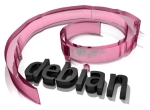 Yups, Debian 6.0 aka “Squeeze” telah resmi dirilis pada 6 Februari 2011.
Yups, Debian 6.0 aka “Squeeze” telah resmi dirilis pada 6 Februari 2011.Berbeda dengan Distro Linux yang lain. Distro yang mempunyai banyak turunan ini sangat mengutamakan kestabilan. Tak heran jika jarak rilisnya mempunyai rentang waktu yang sangat lama. Namun, sebagai Open Source Lover’s
Nah, kali ini kami akan mencoba menjelaskan langkah-langkah instalasi Linux Debian 6.0 ini.
Sebelum kita memulai langkah instalasi, persiapkan terlebih dahulu :
- Master Linux Debian 6.0 yang bisa anda download di sini.
- DVD Repository (jika nantinya Anda ingin menginstal aplikasi pelengkap secara offline)
- Semangat, waktu dan dilengkapi dengan secangkir kopi berserta makanan kecil untuk menemani Anda pada proses penginstalan

- Burning image ISO Debian 6.0 tadi pada sekeping DVD. Anda juga dapat me-restore
image ISO Debian 6.0 tadi pada USB flashdisk / hardisk external jika
ingin menginstal tanpa menggunakan DVD ROM/Drive. Insya Allah
langkah-langkah instalnya melalui USB flashdisk / hardisk external akan
kami ulas pada artikel berikutnya.

- Setting BIOS agar dapat booting melalui DVD ROM / USB flashdisk.
- Booting melalui DVD Debian 6.0 / USB flashdisk.
- Pada screen Installer Boot Menu pilih Advance Options, tekan Enter.
- Pilih Alternative Desktop Environment. Pada Desktop Environment Menu pilih KDE (Anda juga dapat memilih LXDE atau Xfce sesuai selera).
- Pada screen KDE Boot Menu pilih Graphical Install untuk melakukan instalasi dalam mode grafis / GUI.
- Saran saya pada opsi Select Language ini, kita pilih saja English agar lebih mudah dalam pengaturan. Hitung-hitung sekalian mengasah kemampuan bahasa Inggris kita lah.

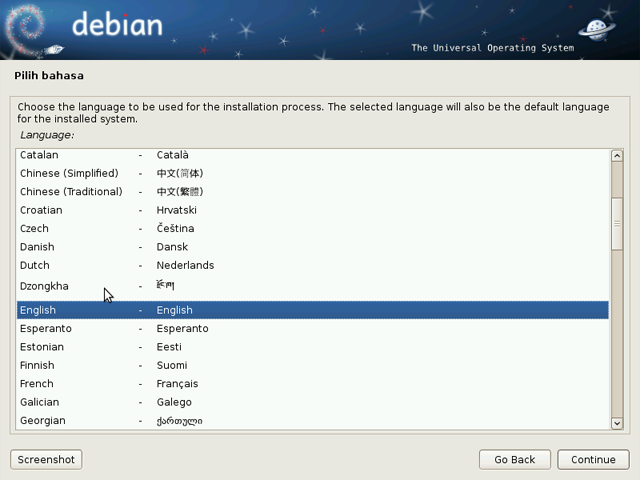
- Berikutnya, karena kita akan memilih Indonesia sebagai domisili kita, maka pada jendela Select your location pilih other, kemudian pilih Asia lalu pilih Indonesia.
- Kemudian pada Configure Locales pilih United States en_us.UTF-8.
- Untuk Configure Keyboard pilih American English.
- Tunggu beberapa saat hingga proses Load Installer Component dari DVD selesai.

- Pada Configure the Network untuk Hostname biarkan sesuai defaultnya (debian). Untuk Domain name dikosongkan saja.
- Set up users and password untuk root password isikan password Anda dan ulangi lagi pada Re-enter password to verify.
- Untuk full name for the new user bisa Anda isikan sesuai
nama lengkap anda. Disarankan tidak memakai tanda spasi untuk memisahkan
nama depan dan nama belakang. Dan pada Username for your account isikan saja nama depan Anda agar lebih mudah diingat.

- Choose a password for the new user isikan password Anda tapi jangan sampai sama dengan password root, karena sebagai User nantinya kita juga bisa melakukan manajemen sistem tanpa harus Login sebagai root sehingga relatif lebih aman.
- Configure the Clock pilih Jakarta sebagai Time Zone. Atau bisa juga kota lain sesuai domisili Anda.
- Berikutnya merupakan langkah Partisi hardisk Anda, simak dengan baik agar tidak terjadi kesalahan yg fatal.

- Jika Anda menginstall Debian 6.0 ini sebagai OS tunggal pada komputer Anda, lebih baik Anda pilih Guided – use entire disk pada Partition methode.
- Bagi Anda yg menginginkan multiboot OS (banyak OS dalam 1 komputer) pilih Manual saja.
- Sebagai contoh disini kami mempunyai ruang hardisk sebesar 8,6 GB yg nantinya akan kita bagi yaitu 8GB untuk root (/) dan sisanya sebagai SWAP area. Maka yg harus dilakukan adalah :
- Klik pada FREE SPACE dan Continue.

- Pilih Create a New Partition untuk memulai proses partisi hardisk.
- Kali ini karena ruang hardisk yang kami punyai 8,6 GB maka untuk New partition size kami isi 8 GB.
- Pada Type for the new partition pilih Primary. Pada Location partition pilih Beginning.
- Berikutnya ubah Bootable flag menjadi On > Done setting up the partition > Continue.
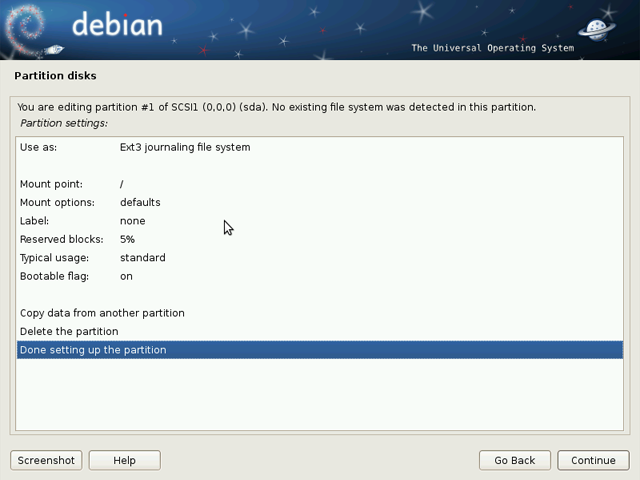
- Untuk men-setting Swap pada sisa partisi hardisk, klik pada FREE SPACE.
- Create a new partition > Size biarkan saja sesuai dengan yg tertera. Type for new partition pilih Logical.
Tips : Swap biasanya ditentukan sebesar 2x jumlah RAM yg anda pakai.
Contoh : RAM yang saya gunakan sebesar 1 GB (1024 MB). Maka partisi Swap yg harus saya buat sebesar 2GB (2048 MB).
Jika Anda mempunyai RAM lebih dari 2 GB, maka Swap cukup dialokasikan sebesar 2 GB saja.
- Untuk Use as : pilih Swap Area. Bootable flag : off dan Done setting up the partition.
- Nah, kini partisi Anda sudah siap, klik Finish partitioning and write changes to disk. Klik Yes pada Write the changes to disk?.
- Waktunya menunggu proses instalasi base system dari Debian 6.0. Monggo, diminum dulu kopinya.


- Configure the packet manager > Scan another CD or DVD ? pilih Yes Jika Anda mempunyai paket repositorynya dan Klik No jika tidak.
- Use a network mirror ? ini merupakan pilihan mutlak bagi Anda yg tidak mempunyai paket repository.
 Klik Yes. Catatan : Anda harus sudah terhubung dengan Internet untuk mendapatkan paket repository ini.
Klik Yes. Catatan : Anda harus sudah terhubung dengan Internet untuk mendapatkan paket repository ini. - Pada Debian archive mirror pilih Indonesia, untuk FTP mirrornya silahkan pilih yang Anda sukai kali ini kami memilih server cdn.debian.net sebagai source list-nya.
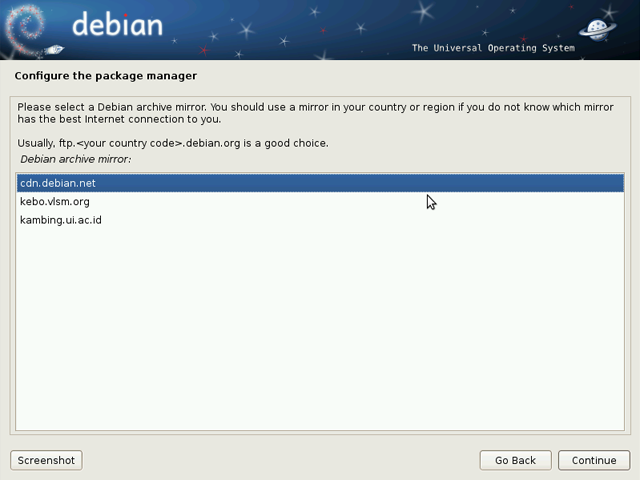 Pada Software Selection Anda dapat memilih aplikasi pelengkap yang Anda inginkan. Saran kami, karena nantinya Debian 6.0 ini hanya digunakan sebagai Desktop OS saja dan bukan sebagai server. Maka centang Graphical Desktop Environment, Laptop dan Standard system Utilities saja untuk memperlengkap aplikasinya.
Pada Software Selection Anda dapat memilih aplikasi pelengkap yang Anda inginkan. Saran kami, karena nantinya Debian 6.0 ini hanya digunakan sebagai Desktop OS saja dan bukan sebagai server. Maka centang Graphical Desktop Environment, Laptop dan Standard system Utilities saja untuk memperlengkap aplikasinya.
- Monggo dimakan cemilannya.
 Kita tunggu sampai proses install paket tersebut selesai.
Kita tunggu sampai proses install paket tersebut selesai. - Sip, proses instalasi aplikasi sudah selesai. Saatnya mengkonfigurasi GRUB.
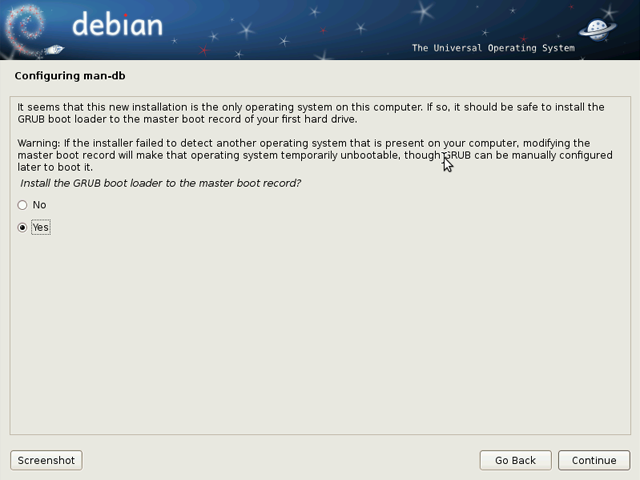
- Pilih Yes, bagi Anda yang menggunakan Debian 6.0 sebagai OS tunggal.
- Tunggu sejenak dan Jreng 3x…. Installation Complete.

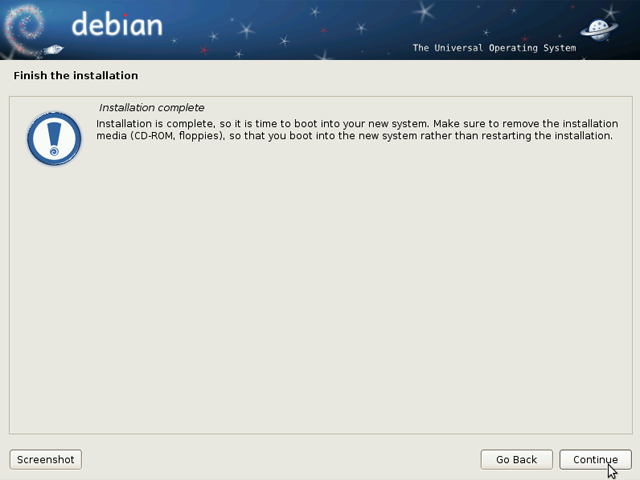
- Restart untuk mulai mengoperasikan.
- Pada Welcome Screen silahkan login sesuai username Anda dan password Anda.

- Inilah desktop Debian 6.0 + KDE Anda !!!

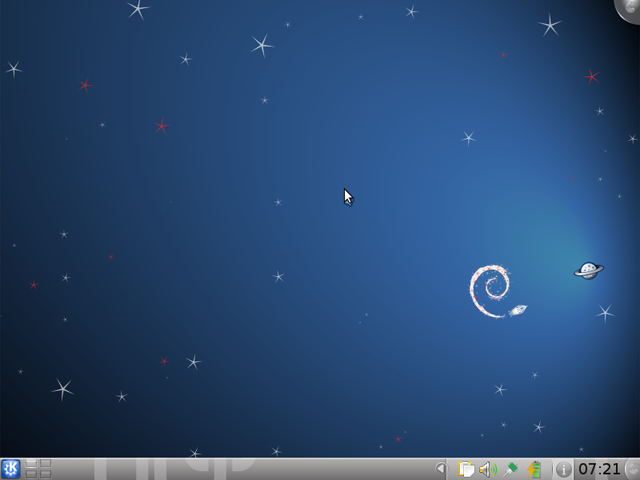
- Tampak polos sekali ya….
 . Hmmmm perlu dikasih kosmetik dikit nih, biar cool….
. Hmmmm perlu dikasih kosmetik dikit nih, biar cool…. 
- Sebagai contoh bisa Anda lihat desktop milik kami saat ini

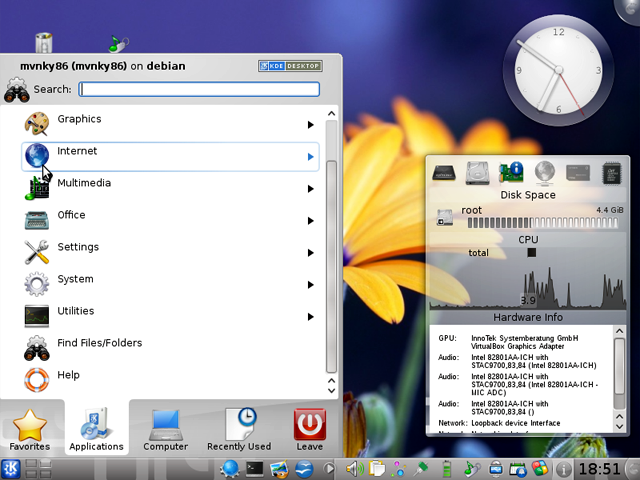
- Demikianlah Cara Instal Linux Debian 6.0 Squeeze. Mudah bukan ?

- GO INDONESIAN OPEN SOURCE !!!

Langganan:
Postingan (Atom)
















